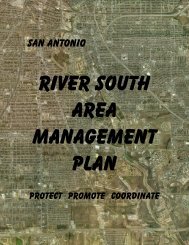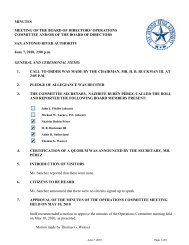concept design san antonio river improvements project
concept design san antonio river improvements project
concept design san antonio river improvements project
You also want an ePaper? Increase the reach of your titles
YUMPU automatically turns print PDFs into web optimized ePapers that Google loves.
GUIDING DESIGN PRINCIPLES<br />
Based upon SAROC’s Guiding Principle and the<br />
Planning Document, Guiding Design Principles have<br />
been developed to guide the planning and <strong>design</strong><br />
direction. These include three major components in<br />
support of SAROC’s goals:<br />
Existing North Channel<br />
“Hydrology”<br />
1. Design solutions will utilize the natural principles<br />
of fluvial geomorphology whenever possible,<br />
especially associated with the pilot channel.<br />
2. Design solutions will not increase flooding<br />
potential and all <strong>design</strong> solutions will attempt to<br />
reduce flooding potential.<br />
3. Design solutions will not increase <strong>river</strong><br />
maintenance and will attempt to reduce<br />
maintenance requirements.<br />
4. No <strong>design</strong> solution will reduce water quality, and all<br />
solutions will attempt to enhance water quality.<br />
5. Adequate base flow will be maintained along with<br />
the impounding of water.<br />
6. Recycled water will take precedence over the<br />
pumping of aquifer water.<br />
7. Public land acquisition will occur, as possible, to<br />
provide greater flood control and <strong>river</strong> flood<br />
carrying capacity.<br />
“Nature”<br />
1. River channel solutions with a more natural<br />
appearance will take precedence over<br />
“architectural” solutions wherever possible and will<br />
have sinuous edges to minimize the artificial<br />
channel appearance.<br />
2. Design solutions will utilize a variety of low flow<br />
conditions such as riffles/pools to increase habitat<br />
diversity and maximize fish and wildlife habitat<br />
value.<br />
3. Fish and wildlife habitats are desired and will be<br />
balanced with other needs of the <strong>river</strong>.<br />
4. Planting solutions will emphasize native and/or<br />
naturalized species and will reduce long-term<br />
mowing requirements to the extent possible.<br />
5. Tree plantings will be maximized, as possible and<br />
coordinated with the appropriate <strong>river</strong> hydraulic<br />
capacity, to provide a variety of scales of spaces<br />
and ecotones, from dense coppices to open areas.<br />
New habitat is a priority<br />
“People”<br />
1. Museum (Northern) Reach and Historical Mission<br />
(Southern) Reach <strong>improvements</strong> will receive<br />
balanced attention.<br />
2. Design solutions will be responsive to the specific<br />
context and will never be “typical”, providing a<br />
variety of experiences for different uses.<br />
3. Design solutions will enhance the appreciation of<br />
the <strong>river</strong>’s historic significance in the life and<br />
development of San Antonio.<br />
4. Pathways will be continuous along the <strong>river</strong>, along<br />
both sides as appropriate, and will interface with<br />
other systems as possible, such as Mission Trails.<br />
5. Safe nighttime use of the <strong>river</strong> will be<br />
accommodated but will not compromise the<br />
integrity of adjacent neighborhoods.<br />
The improved <strong>river</strong> will provide recreational uses for people<br />
6. Future land uses along the <strong>river</strong> will reinforce a<br />
sense of community and respect the human scale,<br />
provide variety and focus intense use in nodes, and<br />
encourage the economic viability of the area.<br />
7. Passive recreational uses (i.e. picnicking) will take<br />
precedence over active recreational uses (i.e.<br />
frisbee). Active recreational uses will occur only<br />
where they are compatible with the context.<br />
8. Design solutions will not increase current trash<br />
accumulation, graffiti, and other maintenance<br />
problems and will attempt to reduce long-term<br />
landscape maintenance requirements.<br />
Wherever possible, the <strong>river</strong> right-of-way should be<br />
expanded as much as possible to increase flood water<br />
capacity, enable tree planting, and provide a more<br />
useable environment for people.<br />
SAN ANTONIO RIVER DESIGN GUIDELINES 17






